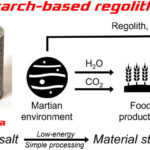2023-03-14 アメリカ合衆国・ウェストバージニア大学 (WVU)
・ WVU が、熱電発電機の効率性を向上させる、高性能の酸化物セラミックス材料を開発。
・ 原子スケールでの結晶粒界のエンジニアリングを通じ、バルクの酸化物セラミックス材料での熱電効率の大幅な向上を初めて実証。大規模・高温度廃熱回収の端緒を開き、酸化物セラミックス材料の新時代を導く。
・ 酸化物セラミックスは、陶器、磁器、粘度レンガ、セメントやシリコンのような材料と同様の種類の材料で様々な金属元素を含有する。熱や腐食に強く硬いため、空気中での高温度アプリケーションに最適で、熱電発電機のコンポーネントの材料として使用できる。
・ ただし、多結晶構造のため結晶間の境界である結晶粒界が電流や電子の移動を妨害して大規模なアプリケーションでは問題となる。新酸化物セラミックス材料では、この障害を踏み台として利用する。
・ 多結晶構造のセラミックスにドーパント(金属イオン)を注入し、結晶粒界に偏析させることで導電経路を確保して熱電性能を向上。現在標準の単結晶材料の性能を上回る、きめの粗い高密度の多結晶材料を作製した。
・ 熱はあらゆる製品の製造に使用されているが、製造プロセスでは約 60%のエネルギーが熱の形で環境に放出されている。本研究は、火力発電所や暖房システム、自動車から放出される廃熱の課題に対処するもの。廃熱回収システムの世界市場は、2026 年までに 70 億ドルを超えると予想されている。
・ 2035 年までに温暖化ガス排出量を最低でも 85%低減する、コスト競争力のある工業熱脱炭素化技術の開発を目指した米国エネルギー省(DOE)の Industrial Heat Shot イニシアティブに即した研究成果として、最先端技術を大幅に超える材料設計を加速させる。
URL: https://wvutoday.wvu.edu/stories/2023/03/14/wvu-lab-s-game-changing-high-performance-semiconductor-material-could-help-slash-heat-emissions
<NEDO海外技術情報より>
関連情報
Renewable and Sustainable Energy Reviews 掲載論文(アブストラクトのみ:全文は有料)
Entering new era of thermoelectric oxide ceramics with high power factor through designing grain
boundaries
URL: https://www.sciencedirect.com/science/article/abs/pii/S1364032123000424?via%3Dihub
Abstract
Thermoelectric oxide ceramics could play a significant role in waste heat recovery using thermoelectric generators, accelerating clean energy generation and achieving net-zero emissions. In 2003, the thermoelectric performance of single-crystal Ca3Co4O9+δ was evaluated with a dimensionless thermoelectric figure-of-merit (ZT) of 0.87. Polycrystalline Ca3Co4O9+δ ceramics are typically only about 30% as efficient as single crystals since they have low electrical conductivity and low Seebeck coefficient. To improve the thermoelectric performance of polycrystalline Ca3Co4O9+δ, a unique approach was developed to drive dopants segregation at the grain boundaries to dramatically increase the Seebeck coefficient and electrical conductivity and total energy conversion efficiency of the oxide. This review exploited our pertinent results from five sets of dopants to elucidate that the grain boundary can be engineered to reverse their detrimental impact on electrical properties and provide the design domain to improve the electrical transport properties significantly. The approach to engineer the grain boundary can be used for the selection of dopants with the appropriate size that will ultimately result in oxide ceramics outperforming single-crystals. The present review unveils the atomic structure origin of the dopant segregation at grain boundaries and presents a feasible and valuable approach for treating the grain boundaries as a two-dimensional intergranular secondary phase complexion that is with magnitudes higher Seebeck coefficient than that of the intragrains. Such intergranular secondary phase complexion is independently tunable to decouple the strongly correlated physical parameters and simultaneously enhance the Seebeck coefficient, electrical power factor, and ZT over a broad temperature range.




